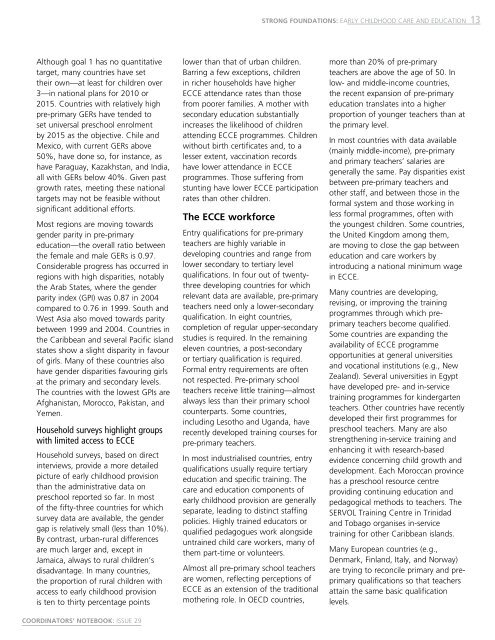A global call to action for early childhood
A global call to action for early childhood
A global call to action for early childhood
You also want an ePaper? Increase the reach of your titles
YUMPU automatically turns print PDFs into web optimized ePapers that Google loves.
Strong foundations: Early <strong>childhood</strong> care and education<br />
13<br />
Although goal 1 has no quantitative<br />
target, many countries have set<br />
their own—at least <strong>for</strong> children over<br />
3—in national plans <strong>for</strong> 2010 or<br />
2015. Countries with relatively high<br />
pre-primary GERs have tended <strong>to</strong><br />
set universal preschool enrolment<br />
by 2015 as the objective. Chile and<br />
Mexico, with current GERs above<br />
50%, have done so, <strong>for</strong> instance, as<br />
have Paraguay, Kazakhstan, and India,<br />
all with GERs below 40%. Given past<br />
growth rates, meeting these national<br />
targets may not be feasible without<br />
significant additional ef<strong>for</strong>ts.<br />
Most regions are moving <strong>to</strong>wards<br />
gender parity in pre-primary<br />
education—the overall ratio between<br />
the female and male GERs is 0.97.<br />
Considerable progress has occurred in<br />
regions with high disparities, notably<br />
the Arab States, where the gender<br />
parity index (GPI) was 0.87 in 2004<br />
compared <strong>to</strong> 0.76 in 1999. South and<br />
West Asia also moved <strong>to</strong>wards parity<br />
between 1999 and 2004. Countries in<br />
the Caribbean and several Pacific island<br />
states show a slight disparity in favour<br />
of girls. Many of these countries also<br />
have gender disparities favouring girls<br />
at the primary and secondary levels.<br />
The countries with the lowest GPIs are<br />
Afghanistan, Morocco, Pakistan, and<br />
Yemen.<br />
Household surveys highlight groups<br />
with limited access <strong>to</strong> ecce<br />
Household surveys, based on direct<br />
interviews, provide a more detailed<br />
picture of <strong>early</strong> <strong>childhood</strong> provision<br />
than the administrative data on<br />
preschool reported so far. In most<br />
of the fifty-three countries <strong>for</strong> which<br />
survey data are available, the gender<br />
gap is relatively small (less than 10%).<br />
By contrast, urban-rural differences<br />
are much larger and, except in<br />
Jamaica, always <strong>to</strong> rural children’s<br />
disadvantage. In many countries,<br />
the proportion of rural children with<br />
access <strong>to</strong> <strong>early</strong> <strong>childhood</strong> provision<br />
is ten <strong>to</strong> thirty percentage points<br />
lower than that of urban children.<br />
Barring a few exceptions, children<br />
in richer households have higher<br />
ECCE attendance rates than those<br />
from poorer families. A mother with<br />
secondary education substantially<br />
increases the likelihood of children<br />
attending ECCE programmes. Children<br />
without birth certificates and, <strong>to</strong> a<br />
lesser extent, vaccination records<br />
have lower attendance in ECCE<br />
programmes. Those suffering from<br />
stunting have lower ECCE participation<br />
rates than other children.<br />
The ECCE work<strong>for</strong>ce<br />
Entry qualifications <strong>for</strong> pre-primary<br />
teachers are highly variable in<br />
developing countries and range from<br />
lower secondary <strong>to</strong> tertiary level<br />
qualifications. In four out of twentythree<br />
developing countries <strong>for</strong> which<br />
relevant data are available, pre-primary<br />
teachers need only a lower-secondary<br />
qualification. In eight countries,<br />
completion of regular upper-secondary<br />
studies is required. In the remaining<br />
eleven countries, a post-secondary<br />
or tertiary qualification is required.<br />
Formal entry requirements are often<br />
not respected. Pre-primary school<br />
teachers receive little training—almost<br />
always less than their primary school<br />
counterparts. Some countries,<br />
including Lesotho and Uganda, have<br />
recently developed training courses <strong>for</strong><br />
pre-primary teachers.<br />
In most industrialised countries, entry<br />
qualifications usually require tertiary<br />
education and specific training. The<br />
care and education components of<br />
<strong>early</strong> <strong>childhood</strong> provision are generally<br />
separate, leading <strong>to</strong> distinct staffing<br />
policies. Highly trained educa<strong>to</strong>rs or<br />
qualified pedagogues work alongside<br />
untrained child care workers, many of<br />
them part-time or volunteers.<br />
Almost all pre-primary school teachers<br />
are women, reflecting perceptions of<br />
ECCE as an extension of the traditional<br />
mothering role. In OECD countries,<br />
more than 20% of pre-primary<br />
teachers are above the age of 50. In<br />
low- and middle-income countries,<br />
the recent expansion of pre-primary<br />
education translates in<strong>to</strong> a higher<br />
proportion of younger teachers than at<br />
the primary level.<br />
In most countries with data available<br />
(mainly middle-income), pre-primary<br />
and primary teachers’ salaries are<br />
generally the same. Pay disparities exist<br />
between pre-primary teachers and<br />
other staff, and between those in the<br />
<strong>for</strong>mal system and those working in<br />
less <strong>for</strong>mal programmes, often with<br />
the youngest children. Some countries,<br />
the United Kingdom among them,<br />
are moving <strong>to</strong> close the gap between<br />
education and care workers by<br />
introducing a national minimum wage<br />
in ECCE.<br />
Many countries are developing,<br />
revising, or improving the training<br />
programmes through which preprimary<br />
teachers become qualified.<br />
Some countries are expanding the<br />
availability of ECCE programme<br />
opportunities at general universities<br />
and vocational institutions (e.g., New<br />
Zealand). Several universities in Egypt<br />
have developed pre- and in-service<br />
training programmes <strong>for</strong> kindergarten<br />
teachers. Other countries have recently<br />
developed their first programmes <strong>for</strong><br />
preschool teachers. Many are also<br />
strengthening in-service training and<br />
enhancing it with research-based<br />
evidence concerning child growth and<br />
development. Each Moroccan province<br />
has a preschool resource centre<br />
providing continuing education and<br />
pedagogical methods <strong>to</strong> teachers. The<br />
SERVOL Training Centre in Trinidad<br />
and Tobago organises in-service<br />
training <strong>for</strong> other Caribbean islands.<br />
Many European countries (e.g.,<br />
Denmark, Finland, Italy, and Norway)<br />
are trying <strong>to</strong> reconcile primary and preprimary<br />
qualifications so that teachers<br />
attain the same basic qualification<br />
levels.<br />
COORDINATORS’ NOTEBOOK: ISSUE 29
















